Themed collection Modalities of induced proximity pharmacology: Degraders and Beyond themed collection

Small molecule modulation of protein polymerization
Small molecules have been shown to not only mediate and enhance polymerization, in a manner analogous to a surface residue mutation or post-translational modification, but also bind and stabilize the repeating unit to inhibit self-assembly.

Chem. Soc. Rev., 2022,51, 2392-2396
https://doi.org/10.1039/D2CS00070A
Proximity-inducing modalities: the past, present, and future
In this review, we highlight bifunctional modalities that perform functions other than degradation and have great potential to revolutionize disease treatment, while also serving as important tools in basic research to explore new aspects of biology.
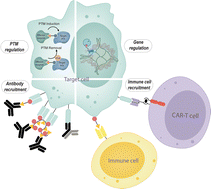
Chem. Soc. Rev., 2023,52, 5485-5515
https://doi.org/10.1039/D2CS00943A
Chemically induced degradation of epigenetic targets
This review summarizes the past and present advances in developing degraders of epigenetic targets which play critical roles in many crucial biological pathways and therefore, targeted for the discovery of therapeutics.

Chem. Soc. Rev., 2023,52, 4313-4342
https://doi.org/10.1039/D3CS00100H
Applications of covalent chemistry in targeted protein degradation
This review summarizes the recent work of covalent chemistry in targeted protein degradation and describes the concept, pros and cons, development, and the outlook of covalent PROTACs.
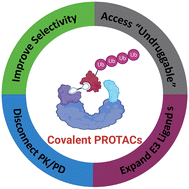
Chem. Soc. Rev., 2022,51, 9243-9261
https://doi.org/10.1039/D2CS00362G
Emerging degrader technologies engaging lysosomal pathways
ATTECs and several other emerging degrader technologies hijacking the lysosomal pathways greatly expand the spectrum of degradable targets and provide new opportunities for targeted drug discovery.

Chem. Soc. Rev., 2022,51, 8832-8876
https://doi.org/10.1039/D2CS00624C
Discovery of small molecule ligands for the von Hippel-Lindau (VHL) E3 ligase and their use as inhibitors and PROTAC degraders
This review provides a comprehensive overview of the structure-based design of small-molecule VHL ligands and their applications as VHL inhibitors and E3 ligase recruiting moieties in PROTAC degraders.

Chem. Soc. Rev., 2022,51, 8216-8257
https://doi.org/10.1039/D2CS00387B
PROTAC degraders as chemical probes for studying target biology and target validation
This review provides guidelines for the optimization of proteolysis targeting chimeras (PROTACs) and outlines criteria for their use as chemical probes.
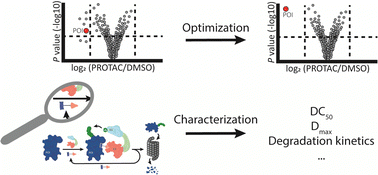
Chem. Soc. Rev., 2022,51, 7971-7993
https://doi.org/10.1039/D2CS00478J
Chemistries of bifunctional PROTAC degraders
Proteolysis targeting chimeras (PROTACs) technology is a novel and promising therapeutic strategy using small molecules to induce ubiquitin-dependent degradation of proteins.
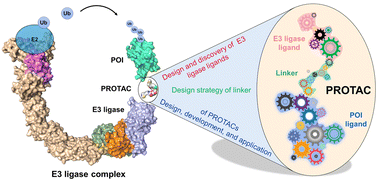
Chem. Soc. Rev., 2022,51, 7066-7114
https://doi.org/10.1039/D2CS00220E
Methods to characterize and discover molecular degraders in cells
This review highlights recent approaches to characterize molecular degraders (monofunctional molecular degraders, PROTACs), or to discover their targets in vitro and in live cells, which can be extended to additional PTMs other than ubiquitination.
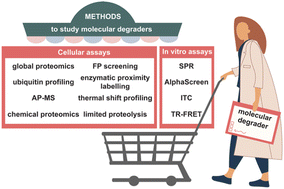
Chem. Soc. Rev., 2022,51, 7115-7137
https://doi.org/10.1039/D2CS00261B
The importance of cellular degradation kinetics for understanding mechanisms in targeted protein degradation
Targeted protein degradation is a dynamic process regulated not only by the kinetics and mechanisms of the degrader compound, but also the native homeostasis and cellular regulation of the target protein. Image created with BioRender.com.

Chem. Soc. Rev., 2022,51, 6210-6221
https://doi.org/10.1039/D2CS00339B
Chasing molecular glue degraders: screening approaches
By orchestrating interactions to an E3 ubiquitin ligase, molecular glue degraders have incredible therapeutic potential against otherwise “undruggable” proteins. We discuss how their discovery is evolving from serendipity to intentional strategies.
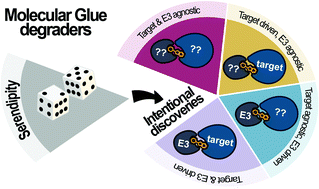
Chem. Soc. Rev., 2022,51, 5498-5517
https://doi.org/10.1039/D2CS00197G
PROTACs: past, present and future
This review highlights important milestones in the evolution of PROTACs, briefly discusses recent lessons about targeted protein degradation, and conjectures on the efforts still needed to expand the toolbox for PROTAC discovery.
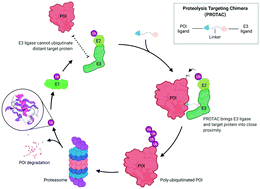
Chem. Soc. Rev., 2022,51, 5214-5236
https://doi.org/10.1039/D2CS00193D
Translational PK–PD for targeted protein degradation
This tutorial review provides practical insights and a proposed roadmap for building the translational PK–PD understanding for protein degrader therapeutics.
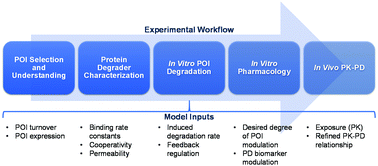
Chem. Soc. Rev., 2022,51, 3477-3486
https://doi.org/10.1039/D2CS00114D
E3 ligase ligand chemistries: from building blocks to protein degraders
This review comprehensively illustrates chemistries of E3 ligase ligands, which were used successfully in the development of PROTACs.
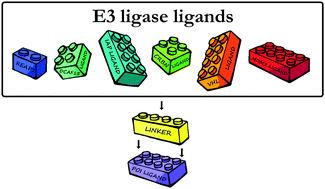
Chem. Soc. Rev., 2022,51, 3487-3534
https://doi.org/10.1039/D2CS00148A
SERDs: a case study in targeted protein degradation
This tutorial review summarizes the recent progress of SERDs and their mechanism of action in the broader context of targeted protein degradation.

Chem. Soc. Rev., 2022,51, 8149-8159
https://doi.org/10.1039/D2CS00117A
Discovery of CRBN as a target of thalidomide: a breakthrough for progress in the development of protein degraders
Thalidomide and its derivatives are the only protein degraders currently used in clinical practice. This tutorial review provides an overview of the mechanism of action of thalidomide-based degraders and their future perspectives.
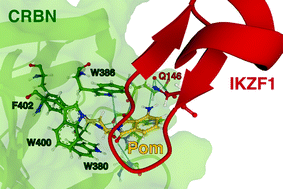
Chem. Soc. Rev., 2022,51, 6234-6250
https://doi.org/10.1039/D2CS00116K
Target and tissue selectivity of PROTAC degraders
In this review, we focus on recent progress towards making selective PROTAC molecules and new PROTAC technologies that will continue to push the boundaries of achieving target and tissue selectivity.
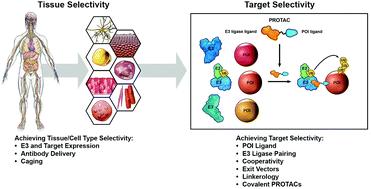
Chem. Soc. Rev., 2022,51, 5740-5756
https://doi.org/10.1039/D2CS00200K
Degrader-antibody conjugates
This review illustrates the design of antibody conjugates which employ chimeric protein degraders (i.e., PROTACs) as payloads and summarizes the examples of such entities that are currently known in the scientific and patent literature.
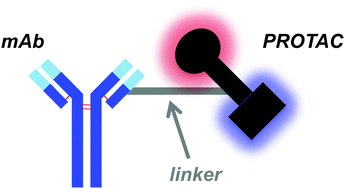
Chem. Soc. Rev., 2022,51, 3886-3897
https://doi.org/10.1039/D2CS00141A
About this collection
Recruiting proteins and other biological macromolecules into spatial proximity is offering a revolutionary new paradigm of chemical biology and drug discovery. Fueled by the remarkable success and clinical reality of degraders such as PROTACs and molecular glues, the approach of bringing proteins together and inducing de novo protein-protein interactions is witnessing an exponential surge in interest and attention across academia and industry. These approaches can modulate target stability, chemical composition, and ultimately function, and as such promise to expand the range of tractable biomolecules.
With this themed collection, Guest Edited by Alessio Ciulli (University of Dundee) and Shaomeng Wang (University of Michigan), we aim to cover the breadth and depth of topics in this expanding new field: from different flavours of degrader molecules, including developments in chemistry and mechanistic understanding, to novel approaches to induced proximity beyond degraders, including modern enabling technologies.